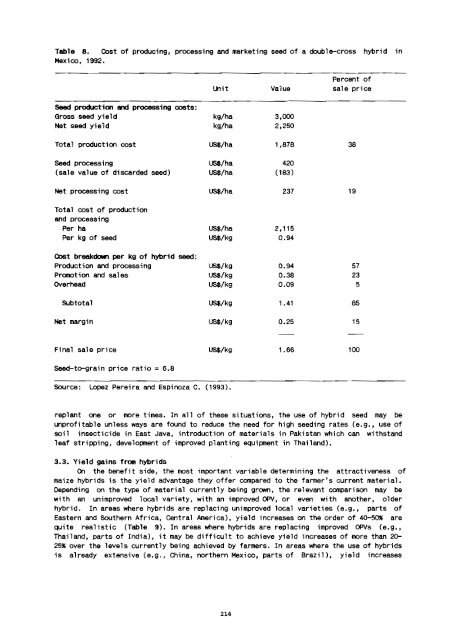Proceedings of the Fifth Asian Regional Maize Workshop - Search ...
Proceedings of the Fifth Asian Regional Maize Workshop - Search ...
Proceedings of the Fifth Asian Regional Maize Workshop - Search ...
You also want an ePaper? Increase the reach of your titles
YUMPU automatically turns print PDFs into web optimized ePapers that Google loves.
Table 8. COst <strong>of</strong> producing, processing and marketing seed <strong>of</strong> a double-cross hybrid in<br />
Mexico, 1992.<br />
Percent <strong>of</strong><br />
unit Value sale price<br />
seed production and processing costs:<br />
Gross seed yield kg/ha 3,000<br />
Net seed yield kg/ha 2,250<br />
Total production cost US$/ha 1,878 38<br />
seed processing US$/ha 420<br />
(sale value <strong>of</strong> discarded seed) US$/ha (183)<br />
Net processing cost US$/ha 237 19<br />
Total cost <strong>of</strong> production<br />
and processing<br />
Per ha US$/ha 2,115<br />
Per kg <strong>of</strong> seed US$/kg 0.94<br />
Cost breakdown per kg <strong>of</strong> hybrid seed:<br />
Production and processing US$/kg 0.94 57<br />
Promotion and sales US$/kg 0.38 23<br />
OVerhead US$/kg 0.09 5<br />
Subtotal US$/kg 1.41 85<br />
Net margin US$/kg 0.25 15<br />
Final sale price US$/kg 1.66 100<br />
seed-to-grain price ratio =6.8<br />
Source: Lopez Pereira and Espinoza C. (1993).<br />
replant one or more times. In all <strong>of</strong> <strong>the</strong>se situations, <strong>the</strong> use <strong>of</strong> hybrid seed may be<br />
unpr<strong>of</strong>itable unless ways are found to reduce <strong>the</strong> need for high seeding rates (e.g., use <strong>of</strong><br />
soil insecticide in East Java, introduction <strong>of</strong> materials in Pakistan which can withstand<br />
leaf stripping, development <strong>of</strong> improved planting equipment in Thailand).<br />
3.3. Yield gains from hybrids<br />
on <strong>the</strong> benefit side, <strong>the</strong> most important variable determining <strong>the</strong> attractiveness <strong>of</strong><br />
maize hybrids is <strong>the</strong> yield advantage <strong>the</strong>y <strong>of</strong>fer compared to <strong>the</strong> farmer's current material.<br />
Depending on <strong>the</strong> type <strong>of</strong> material currently being grown, <strong>the</strong> relevant comparison may be<br />
with an unimproved local variety, with an improved OPV, or even with ano<strong>the</strong>r, older<br />
hybrid. In areas where hybrids are replacing unimproved local varieties (e.g., parts <strong>of</strong><br />
Eastern and Sou<strong>the</strong>rn Africa, Central America), yield increases on <strong>the</strong> order <strong>of</strong> 40-5~ are<br />
quite realistic (Table 9). In areas where hybrids are replacing improved OPVs (e.g.,<br />
Thailand, parts <strong>of</strong> India), it may be difficult to achieve yield increases <strong>of</strong> more than 20<br />
25% over <strong>the</strong> levels currently being achieved by farmers. In areas where <strong>the</strong> use <strong>of</strong> hybrids<br />
is already extensive (e.g., China, nor<strong>the</strong>rn Mexico, parts <strong>of</strong> Brazil), yield increases<br />
214

















